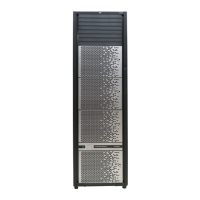Connecting the disk array
The HP service representative performs the following steps to connect the disk array to the host:
1. Verifying operational status of the disk array channel adapters, LDEVs, and paths.
2. Connecting the Fibre Channel cables between the disk array and the fabric switch or host.
3. Verifying the ready status of the disk array and peripherals.
Adding the new device paths to the system
After configuring the FCAs and to ensure the new devices are recognized, some FCA drivers
require you to configure each LUN individually (either through the driver configuration file or in
/kernel/drv/sd.conf).
CAUTION: To ensure that the system can boot properly even if you make a mistake in the driver
configuration file, add the new paths at the end of the file. (This ensures that the system boot entries
higher up in the file will execute first.)
Pre-configure additional LUNs (not yet made available) to avoid unnecessary reboots. See “Installing
and configuring the FCAs” (page 71) for individual driver requirements.
Verifying host recognition of disk array devices
Verify that the host recognizes the disk array devices as follows:
1. Use format to display the device information.
2. Check the list of disks to verify the host recognizes all disk array devices. If any devices are
missing or if no array devices are shown, check the following:
• SAN (zoning configuration and cables)
• Disk array path configuration (FCA HBA WWNs, host group 09 and host group mode
7 set, and LUNs defined for the correct array ports)
Verify that host group 09 and host group mode 7 are set. Although host group mode 7
is required only with the Oracle SAN driver stack, always setting it is a best practice.
• Host FCA configuration (WWN information, driver instance, target and LUN assignment,
and /var/adm/messages)
• If you are using the Oracle SAN driver and XP7 LUNs were not present when the
configuration was done, you may need to reset each FCA if no LUNs are visible. The
following example shows the commands to detect the FC-fabric attached FCAs (c3, c5)
and resetting them.
# cfgadm -l | grep fc-fabric
c3 fc-fabric connected configured unknown
c5 fc-fabric connected configured unknown
# luxadm -e forcelip /dev/cfg/c3
# luxadm -e forcelip /dev/cfg/c5
Configuring disk array devices
Disk arrays are configured using the same procedure for configuring any new disk on the host.
This typically includes the following procedures:
1. “Labeling and partitioning the devices” (page 77)
2. “Creating the file systems” (page 77)
3. “Creating the mount directories” (page 78)
TIP: Creating scripts to configure all devices at once could save you considerable time.
76 Solaris

